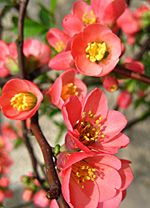 A native of China, flowering quince, was widely grown for in this country and Europe in hedges for many years until they were replaced by Japanese barberry which was more disease resistant. Too bad because the bright colored flowers in early spring are a knock-out. Unfortunately, that is where the beauty of flowering quince ends. The rest of the year it is a tangled mass of twiggy branches. The red-bronze foliage appears after the flowers have bloomed and turn dark green. The branches are covered with thorns and make the shrub an excellent choice for a barrier hedge. The fruits may be harvested in the fall and made into jelly. Many cultivars are available varying in flower size and color. Plants make excellent subjects for bonsai.
A native of China, flowering quince, was widely grown for in this country and Europe in hedges for many years until they were replaced by Japanese barberry which was more disease resistant. Too bad because the bright colored flowers in early spring are a knock-out. Unfortunately, that is where the beauty of flowering quince ends. The rest of the year it is a tangled mass of twiggy branches. The red-bronze foliage appears after the flowers have bloomed and turn dark green. The branches are covered with thorns and make the shrub an excellent choice for a barrier hedge. The fruits may be harvested in the fall and made into jelly. Many cultivars are available varying in flower size and color. Plants make excellent subjects for bonsai.
Type: Deciduous, flowering shrub
Outstanding Feature: Bright colored flowers in early spring
Form: Rounded
Growth Rate: Moderate
Bloom: White, pinks, and reds single, semi-double, or double flowers 1.5” across are borne in clusters of 2-4 in early spring.
Foliage: Opens red-bronze turning to green in summer
Size: 6-10’ H x 6-10’ W; dwarf cultivars available
Light: Full sun to part shade
Soil: Average, moist, well-drained, slightly acid; tolerates some dryness
Hardiness: Zones 4-8
Care: Prune to renew flowering when necessary
Pests and Diseases: Root rot in moist soil; susceptible to scale, scab, mites, aphids
Propagation: Cuttings in summer; seeds need cold stratification
Outstanding Examples:
 ‘Cameo’ (double, apricot-pink flowers; disease resistant; low growing, 4-5’ high)
‘Cameo’ (double, apricot-pink flowers; disease resistant; low growing, 4-5’ high) ‘Nivalis’ (single, white, flowers).
‘Nivalis’ (single, white, flowers).